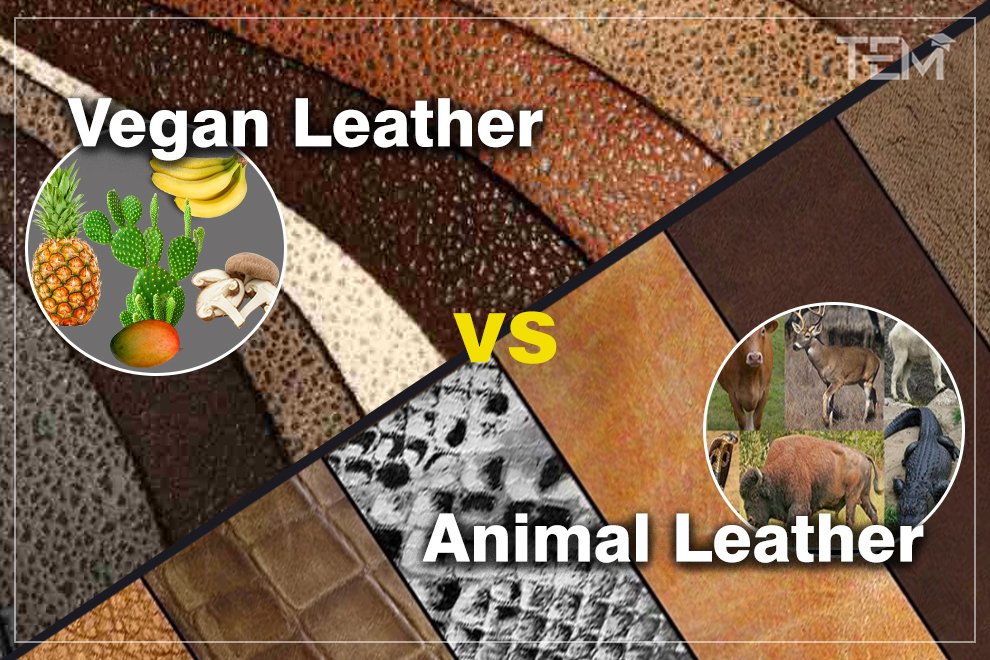Are you a fashion freak who loves to rock the latest trends and styles? Do you also care about the environment and the animals who share this planet with us? If you answered yes to both questions, then you might be interested in learning more about vegan leather.
But before we proceed, did you know the market size of the vegan leather industry? As per the reports of research and markets the market size is estimated to be around USD 48.33 billion in the year 2023.
Vegan leather is a material that mimics the look and feel of animal leather but is made from synthetic or plant-based sources. It is gaining popularity as an alternative to animal leather, due to ethical, environmental, and aesthetic reasons.
In this blog post, we will compare vegan leather and animal leather, highlight the benefits of vegan leather, describe the different types and sources of vegan leather, and give you some tips on how to use and care for vegan leather products.
Whether you are already a fan of vegan leather or just curious about it, we hope you will find this blog post informative and helpful. Let’s get started!
Vegan Leather vs. Animal Leather

If you love leather but hate the cruelty and environmental damage it causes, you might want to consider vegan leather as a better alternative.
Vegan leather is a material that mimics the look and feel of animal leather but is made from synthetic or plant-based sources.
Now let’s have a look at some of the key differences between vegan leather and animal leather based on the following criteria: animal welfare, environmental footprint, durability and quality, and style and variety.
Animal Welfare
Vegan leather stands out from animal leather as it spares animals from harm and death. Animal leather demands the slaughter of over a billion animals annually, encompassing cows, pigs, sheep, goats, alligators, snakes, and kangaroos.
PETA highlights inhumane conditions like overcrowding, mutilation, branding, and castration before animals are skinned alive or electrocuted. Opting for vegan leather means rejecting this industry, offering a compassionate alternative, and potentially saving numerous lives.
Environmental Footprint
Vegan leather, sourced from materials like pineapple leaves and recycled plastics, offers an eco-friendly substitute for animal leather.
Unlike traditional leather, it minimizes environmental impact by reducing land, water, and energy usage.
A 2017 study found that traditional leather contributes to 10% of global greenhouse gas emissions and 20% of global water consumption, leading to waste and pollution.
Opting for vegan leather not only addresses these issues but also provides the benefit of biodegradability or recyclability, promoting a more sustainable and responsible fashion choice.
Durability and Quality
Vegan leather, designed to match animal leather in strength and flexibility, may lack longevity compared to traditional leather.
Varieties using polyurethane (PU) or polyvinyl chloride (PVC) can deteriorate, releasing microplastics when washed.
Plant-based options offer biodegradability but may not match animal leather’s water, stain, or abrasion resistance. Balancing sustainability and performance requires choosing high-quality vegan leather tailored to individual needs.
Style and Variety
Vegan leather, an ethical alternative to animal leather, offers diverse colors and textures without natural skin limitations. It drives innovation in products like pineapple-based Piñatex shoes and apple peel, cork, and algae foam jackets.
Brands such as HOZEN and VEERAH showcase their versatility, surpassing animal leather in creativity.
In fashion, vegan leather provides comparable or superior benefits without cruelty or a large carbon footprint. Opt for it to embrace an ethical, eco-conscious style and support a sustainable future.
Benefits of Vegan Leather
If you are looking for a way to enjoy leather without compromising your values, vegan leather is the perfect solution.
Vegan leather is a material that mimics the look and feel of animal leather but is made from synthetic or plant-based sources. Vegan leather has many benefits, such as:
Cruelty-free
vegan leather is a compassionate choice that does not contribute to animal suffering or exploitation.
Unlike animal leather, which requires the killing of millions of animals every year, vegan leather does not harm any living beings.
By choosing vegan leather, you can show your respect and love for all animals, and support the animal rights movement.
Eco-friendly
Vegan leather can help reduce greenhouse gas emissions, water pollution, and deforestation caused by the animal leather industry.
According to a 2017 study, leather has the highest environmental impact of any material used in the fashion industry, accounting for 10% of the global greenhouse gas emissions and 20% of the global water consumption.
Vegan leather, on the other hand, can be made from materials that have a lower environmental impact, such as pineapple leaves, mushrooms, cactus, cork, bamboo, and recycled plastic. Some vegan leathers are also biodegradable or recyclable, which reduces waste and landfill.
Affordable
Vegan leather is generally cheaper than animal leather, as it does not require as much resources or labor to produce.
Animal leather is a scarce and expensive commodity, as it depends on the availability and quality of animal skins.
Vegan leather, however, can be mass-produced and easily modified, which lowers the cost and increases the supply.
You can find vegan leather products at various price ranges, from affordable to luxury, depending on the brand and the quality of the material.
Versatile
Vegan leather can be used for a wide range of products, such as clothing, footwear, accessories, furniture, and more.
Vegan leather can also suit different styles, tastes, and occasions, as it can be customized to look like various types of animal leather, such as cowhide, suede, or snakeskin.
You can find vegan leather products in different colors, textures, and patterns, which can enhance your appearance and express your personality.
Types and Sources of Vegan Leather
If you are curious about the different types and sources of vegan leather, you might be surprised to learn that there are many options available in the market.
Vegan leather is a material that mimics the look and feel of animal leather but is made from synthetic or plant-based sources.
As we go deep inside this topic, it’s essential to look at the different types and sources of vegan leather and explain their pros and cons.
Synthetic Vegan Leather

Synthetic vegan leather, derived from petroleum-based plastics like polyurethane or polyvinyl chloride, is the most prevalent vegan leather type.
Despite its widespread availability and customizable features such as color and texture, it poses environmental concerns.
Non-biodegradable and prone to cracking, it may release harmful microplastics during washing, impacting marine life and human health. Brands using this material include
Wills Vegan Shoes
A PETA-certified vegan shoe brand that uses high-quality PU and eco-friendly materials to create stylish and comfortable shoes for men and women.
Broke Mate
A PETA-approved vegan-certified company that makes fashionable and practical bags and accessories from PU and other cruelty-free materials.
Stella McCartney
A luxury fashion brand that is known for its ethical and sustainable practices, and uses PU and recycled polyester to create vegan leather products, such as jackets, bags, and belts.
Plant-based Vegan Leather

Plant-based vegan leather, crafted from organic sources like pineapple leaves, apple skins, cork, kelp, mushroom, or cactus, stands out as an eco-friendly alternative.
Despite its lower environmental impact and biodegradability, challenges include reduced durability, higher costs, and limited accessibility compared to synthetic alternatives. It may lack resistance to water, stains, and abrasion, demanding more careful maintenance.
Brands embracing this innovation include those using plant-based vegan leather, presenting a sustainable but nuanced choice in the eco-conscious market.
Piñatex
A natural leather alternative made from pineapple leaf fibers, which are a by-product of the pineapple harvest.
Piñatex is strong, flexible, and breathable, and can be used for various products, such as shoes, bags, and clothing.
Malai
A newly developed biocomposite material made from entirely organic and sustainable bacterial cellulose, which is grown on agricultural waste sourced from the coconut industry in Southern India. Malai has the look and feel of leather and can be dyed, embossed, or stitched.
Desserto
A plant-based leather made from cactus, which is grown organically and sustainably in Mexico.
Desserto is soft, smooth, and durable, and can be used for various products, such as furniture, car interiors, and fashion accessories.
Tips on How to Use and Care for Vegan Leather Products
If you have decided to buy or own some vegan leather products, you might be wondering how to use and care for them properly.
Vegan leather is a material that mimics the look and feel of animal leather but is made from synthetic or plant-based sources.
Vegan leather products can last for a long time and look great if you follow some simple tips and tricks.
As we move ahead, we will look at some of the tips on how to use and care for your vegan leather products, and share some personal experiences or tips on how we use and care for ours.
- Follow the label instructions for cleaning and storing your vegan leather product, as various types have distinct requirements. For instance, synthetic options may be machine washable, while plant-based alternatives might require hand-washing or dry-cleaning. Some varieties should be stored in a cool, dry place to prevent fading or cracking, away from direct sunlight or heat. Prioritize checking the label and adhering to the manufacturer’s recommendations for washing and storage.
- Protect your vegan leather product from sunlight, heat, and moisture to prevent fading, cracking, or mold. Extreme temperatures and humidity can impact color, shape, and quality, especially in hot or humid climates. Shield your product from the elements using a vegan leather protector spray, umbrella, or cover if used outdoors. Additionally, employ a dehumidifier or silica gel packet to maintain dryness and freshness.
- Clean vegan leather with a soft cloth, mild soap, and warm water to remove dirt or stains. Avoid harsh chemicals like bleach. Use a microfiber cloth and mild soap (baby shampoo or dish soap) in circular motions, avoiding vigorous scrubbing. Air dry away from direct sunlight or heat to maintain cleanliness and shine. Regular, gentle cleaning preserves the condition of your vegan leather items for everyday use.
- Keep vegan leather items in top shape by applying a conditioner or protector every few months. This maintains moisture, softness, and shine. Vegan leather may lose these qualities, requiring extra care. Use a specialized product available online or in stores, or make one at home with coconut oil, olive oil, or beeswax. Apply a thin layer, let it soak, then wipe off excess. Enjoy your refreshed vegan leather with improved appearance and texture.
- Swiftly repair tears or holes in vegan leather with patches, glue, or a sewing kit. Whether from wear or accidents, restore functionality and aesthetics. Obtain supplies online or at craft stores, and repurpose old items as patches. Match color and texture, apply glue, or sew the patch over the tear. Align edges, and smooth wrinkles, and let glue dry or stitch set. Your vegan leather item will be as good as new.
Conclusion
With the growing demand for vegan leather, the experts have made their projections indicating the growth of this industry with a CAGR of 11.06%, reaching USD 81.66 billion by 2030.
And with that, we have reached the end of this blog post, and we hope you have learned a lot about vegan leather. As we have seen, vegan leather is the future of fashion, and it can make you happy and satisfied in many ways.
By choosing vegan leather, you can show your love and respect for animals and the environment, and also express your personality and style. We encourage you to try vegan leather for yourself, or share it with your friends and family, and discover the amazing products that are available in the market. Also, let us know what you think of this topic and share your experience of using vegan leather.










